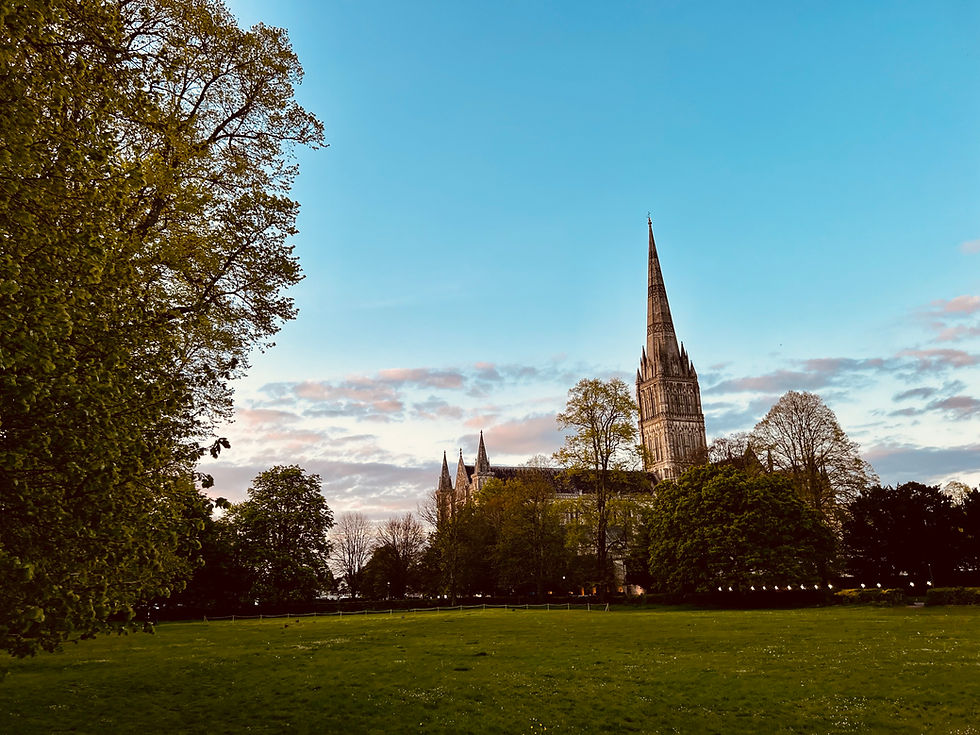A Royal Encounter at Stonehenge: Meeting Gertrude the Great Bustard
- Sandrine Maubeche

- Apr 13
- 3 min read
Today, while leading a tour near the ancient stones of Stonehenge, a student quietly interupted my explanation about Solstice Alignments:
"Excuse me", she said, pointing just over my shoulder, "what bird is that behind you?"
I turn around, mid-sentence, expecting perhaps a pigeon or a creepy crow, and then gasped, eyes wide. "It's Gertrude!" I practically shouted. "Gertrude the Great Bustard!"

She stood there in the shimmering distance, her broad chest puffed, looking entirely regal against the majestic stones. If you've never seen a Great Bustard before, imagine a bird the size of a small deer - massive, with a proud bearing, strong legs, and a stunning mottled plummage of coppery browns and soft whites. Gertrude, in particular, has a reputation. She's somewhat of a local celebrity among those who know where to look.

To everyone's astonishment, she began to move slowly towards us - cautious but clearly curious. Her eyes seemed fixed on one guest inparticular: a lady in a bright orange coat. Gertrude appeared positively intrigued, tilting her head, taking a few deliberate steps closer, as if sizing her up. It was one of those surreal, silent moments where time folds in on itself - and it felt like we were part of something ancient and symbolic.
Gertrude is one of the few Great Bustards reintroduced to Salisbury Plain, not far from Stonehenge, and she has taken a liking to the sacred site. Every April and May, just as spring awakens the chalk grasslands and the wind carries the soft hum of bees and larks, Gertrude makes her way to the stones. Some say she comes for the sun. I like to think that she comes for the company or looking for love.
She tends to show up when visitors lease expect it - often behind a guide giving a passionate explanation about Neolithic burial rites. I can't blame her. Afterall, Stonehenge has always drawn those with a sense of ceremony and mystery.
The reason she's such a rare sight in England is tied to a rather tragic past. Great Bustards were once native to our isles, but due to hunting and agricultural changes they went extinct here in the 1830s. these impressive birds - among the heaviest flying birds in the world - were highly prized for their meat and feathers, and their large open nesting grounds were steadily claimed by expanding farms.
But in recent years, thanks to the conservation efforts and a reintroduction programme led by the Great Bustard Group, these birds have slowly been making a comeback on the Wiltshire Plains. It's still delicate work. Bustards are shy creatures, wary and easily disturbed. Yet Gertrude seems to defy the odds, showing up year after year with a quiet confidence, as if she remembers a time when the land was hers.
And yes, for those wondering, Stonehenge isn't just for druids and tourists - many of us Salisbury City Guides also lead tours here, sharing stories that bridge the ancient and the modern, the earthly and the celestial. Gertrude has become part of that tapestry now, her annual appearance a cherished thread in the story we tell.
So yes, I told the student with pride, that was no ordinary bird. That was Gertrude, our very own feathered dignitary. A symbol of return, resilience, and -dare I say - a perfect companion to the ancient drama of Stonehenge.
If you're visiting in April or May keep your eyes open, Gertrude might just be behind you. And if you're wearing orange she might just say hello!




Comments